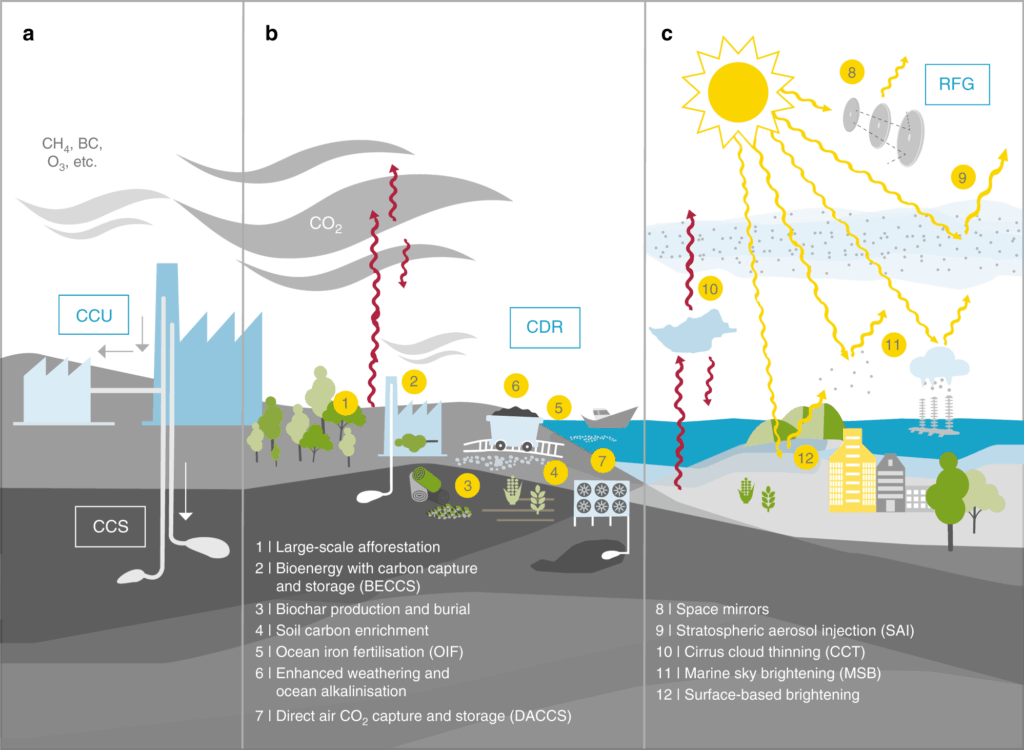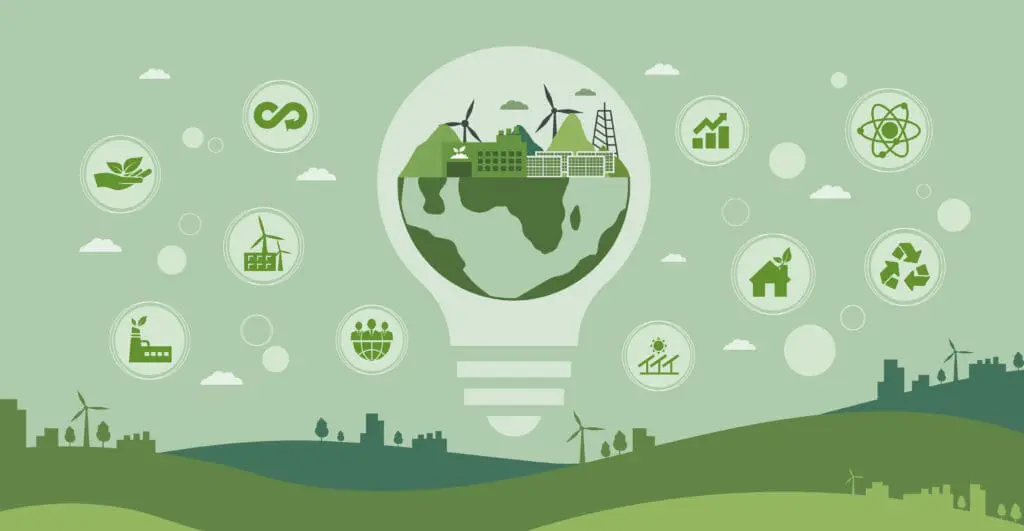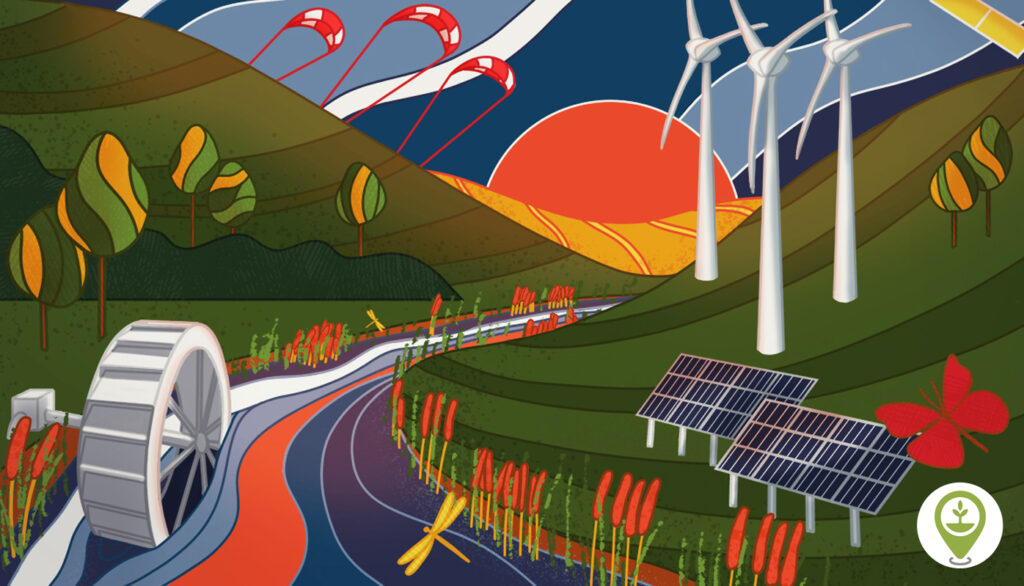The question of whether technology can reverse climate change has evolved from theoretical speculation to urgent practical necessity. As global temperatures continue rising and traditional mitigation efforts fall short of climate targets, revolutionary technologies are emerging that could fundamentally transform our relationship with atmospheric carbon dioxide and planetary heating. In this article, we will try to answer the question Can Technology Reverse Climate Change?
Understanding Climate Reversal vs. Mitigation
Climate change reversal differs fundamentally from mitigation. While mitigation focuses on reducing future emissions, reversal technologies actively remove existing greenhouse gases from the atmosphere or counteract their warming effects. This distinction is crucial for understanding the potential of emerging climate technologies.
The Intergovernmental Panel on Climate Change (IPCC) has made clear that limiting global warming to 1.5°C will require not just dramatic emissions reductions, but also large-scale deployment of carbon removal technologies. This dual approach, combining emission cuts with active atmospheric intervention, represents the new frontier in climate solutions.
Revolutionary Carbon Removal Technologies
Direct Air Capture (DAC) technology represents one of the most promising approaches to climate reversal. Swiss company Climeworks has developed the world’s first commercial DAC facility, capable of removing 4,000 tonnes of CO2 annually from ambient air. The captured carbon is then permanently stored underground, where it mineralizes into stable rock formations.
Recent breakthrough research at UC Berkeley has yielded a Covalent Organic Framework (COF) material that dramatically improves DAC efficiency. This ultra-porous crystalline material can clean ambient air completely of CO2, with just 200 grams capable of capturing 20 kilograms of CO2 annually—equivalent to a tree’s carbon absorption. The material maintains performance after 100 cycles, demonstrating the durability required for industrial applications.
Technology Acceptance Model in Carbon Capture
The Technology Acceptance Model (TAM) provides crucial insights into DAC adoption challenges. Key factors influencing acceptance include:
Perceived Usefulness: Stakeholders must recognize DAC’s potential to achieve negative emissions and climate reversal
Perceived Ease of Use: Complex deployment requirements create adoption barriers
Cost Considerations: Current DAC costs exceed $600 per tonne, though experts predict reductions below $200 per tonne within two decades
Technology business management strategies must address these acceptance factors while scaling DAC operations to gigatonne levels required for meaningful climate impact.
Artificial Intelligence is The Climate Solution Multiplier

AI-Powered Emissions Reductions
Artificial Intelligence emerges as perhaps the most versatile climate technology, capable of reducing global emissions by 3.2 to 5.4 billion tonnes of CO2 equivalent annually by 2035. This potential reduction exceeds the total annual emissions of the United States, demonstrating AI’s transformative capacity.
AI’s climate impact operates across three critical sectors:
Energy Systems: AI optimizes renewable energy grid management, increasing solar and wind load factors by up to 20%. Smart grid technologies powered by AI can reduce energy waste and enhance the integration of variable renewable sources.
Food Production: AI can improve alternative protein adoption rates from 8-14% in business-as-usual scenarios to 18-33% in ambitious AI deployment scenarios, potentially reaching 27-50% in highly ambitious scenarios.
Transportation: AI-enabled optimization of transport systems could reduce emissions by 0.5-0.6 billion tonnes CO2 equivalent annually.
AI Carbon Footprint Management
The technology acceptance model proves essential for AI climate solutions adoption. Organizations implementing AI for carbon footprint reduction report 18% higher return on investment due to energy savings and operational efficiency gains. However, AI’s own energy consumption creates implementation challenges that must be addressed through renewable energy-powered data centers
Nuclear Fusion: The Ultimate Clean Energy Solution

Breakthrough Achievements in 2024-2026
Nuclear fusion technology has achieved unprecedented milestones, bringing commercial viability closer to reality. The UK’s JET laboratory set a new world record, producing 69 megajoules of energy over five seconds, enough to power four to five hot baths. While modest, this achievement represents crucial progress toward energy-positive fusion reactions.
China has emerged as a major fusion competitor, allocating an estimated $1.5 billion annually to fusion research, nearly double the US government’s 2024 fusion budget. This international competition accelerates technological development and commercial deployment timelines.
Fusion Technology Business Applications
Technology business management in the fusion sector involves managing complex public-private partnerships and massive capital requirements. Private investment in fusion companies has exceeded $5 billion over the past two years, indicating strong market confidence in commercial viability.
New Zealand startup OpenStar Technologies recently achieved plasma temperatures of 300,000 degrees Celsius using just $10 million in funding over two years, demonstrating more cost-effective development approaches. This achievement suggests fusion technology could become accessible to smaller companies and accelerate innovation cycles.
Geoengineering: Planetary-Scale Climate Intervention

Solar Radiation Management Technologies
Solar Radiation Management (SRM) represents the most controversial yet potentially powerful climate intervention technology. SRM approaches work by reflecting sunlight away from Earth rather than removing greenhouse gases from the atmosphere.
The two primary SRM methods under development include:
Stratospheric Aerosol Injection (SAI): Introducing reflective particles into the upper atmosphere to mimic volcanic cooling effects. The 1991 Mount Pinatubo eruption demonstrated SRM’s potential by cooling global temperatures by 0.5°C for one year.
Marine Cloud Brightening (MCB): Injecting sea salt aerosols into low-level marine clouds to increase their reflectivity. Ship tracks provide natural analogs, showing small but measurable global cooling effects.
SRM Technology Acceptance Challenges
Technology acceptance models reveal significant barriers to SRM deployment. Unlike other climate technologies, SRM faces unique governance challenges due to its global effects and relatively low deployment costs. A single nation could theoretically deploy SRM unilaterally, creating international tensions and regulatory uncertainties.
Critical acceptance factors include:
Termination Risk: SRM must be maintained for centuries, creating multi-generational commitments
Regional Effects: Climate impacts vary globally, creating winners and losers
Moral Hazard: SRM availability might reduce emissions reduction urgency
Ocean-Based Climate Solutions

Ocean Alkalinity Enhancement
Ocean Alkalinity Enhancement (OAE) leverages the ocean’s natural carbon absorption capacity. By adding alkaline substances like crushed limestone or olivine to seawater, OAE can increase the ocean’s CO2 storage capacity while countering ocean acidification.
Research indicates each tonne of alkalinity added can sequester 0.8-1.5 tonnes of CO2, with the carbon remaining stored for approximately 10,000 years. Italian company Limenet has developed a breakthrough pH-equilibrated process that produces calcium bicarbonate solutions for controlled ocean deployment.
Marine CDR Technology Management
Technology business management in the marine sector faces unique challenges, including ocean governance frameworks, environmental monitoring requirements, and assessments of the impact on marine ecosystems. Companies must navigate complex international water regulations while demonstrating ecological safety.
Forest Restoration with Nature and Enhanced Technology

AI-Powered Reforestation
Forest restoration technology has evolved beyond traditional tree planting to incorporate sophisticated AI and robotics systems. Drone-based planting systems can now plant over 100,000 trees daily while monitoring illegal logging and biodiversity threats.
Satellite-powered AI systems predict optimal forest restoration sites and species selection, dramatically improving restoration success rates. This combination of natural carbon sequestration with technological precision offers scalable climate solutions.
Forest Carbon Sequestration Potential
Research from Zurich’s Crowther Lab demonstrates that reforesting 900 million hectares could sequester 100-200 billion tonnes of carbon. Forest restoration technology applications include:
Remote Sensing: High-resolution satellite imagery and LiDAR for precise forest mapping
Predictive Modeling: AI algorithms for optimal planting strategies and forest health monitoring
Automated Seeding: Drone swarms capable of large-scale seed deployment
Technology Integration and Business Models

Comprehensive Climate Technology Portfolios
Technology business management increasingly focuses on integrated climate solution portfolios rather than single technologies. Successful climate companies combine multiple approaches:
Carbon Capture + Renewable Energy: Powering DAC facilities with dedicated solar or wind installations
AI + Traditional Solutions: Using machine learning to optimize existing renewable energy and efficiency systems
Nature + Technology: Enhancing natural climate solutions with monitoring and optimization technologies
Climate Technology Adoption Models
The Technology Acceptance Model reveals critical success factors for climate technology deployment:
Economic Viability: Technologies must demonstrate clear financial returns or cost savings
Regulatory Support: Government policies and incentives drive adoption rates
Social Acceptance: Public understanding and support influence deployment speed
Technical Reliability: Proven performance reduces adoption resistance
Investment and Scaling Challenges
Financial Requirements for Climate Reversal
Achieving meaningful climate reversal requires unprecedented technology deployment scales. Current estimates suggest:
Direct Air Capture: Scaling to gigatonne removal levels requires thousands of industrial facilities
Nuclear Fusion: Commercial deployment demands continued multi-billion-dollar investments
Solar Geoengineering: Relatively low costs but massive governance infrastructure requirements
Technology Business Models
Successful technology business management in climate solutions requires innovative financing approaches:
Carbon Credit Markets: Monetizing CO2 removal and storage services
Corporate Partnerships: Long-term contracts with companies pursuing net-zero commitments
Government Procurement: Public sector purchasing of climate services
Blended Finance: Combining public and private capital for risk sharing
Regional Technology Applications
Developed vs. Developing Nation Strategies
Technology applications vary significantly based on regional capabilities and needs:
Developed Nations: Focus on advanced technologies like DAC, fusion, and geoengineering research
Developing Nations: Emphasize renewable energy deployment, forest restoration, and adaptation technologies
Island Nations: Priority on sea-level rise mitigation and renewable energy independence
Technology Transfer and Capacity Building
Technology acceptance models emphasize the importance of local capacity for the success of climate technology. Effective deployment requires:
Technical Training: Local workforce development for technology operation and maintenance
Infrastructure Development: Grid modernization and support systems
Institutional Capacity: Regulatory frameworks and governance systems
Future Technology Roadmap

Emerging Technologies on the Horizon
Several breakthrough technologies could emerge as game-changers:
Advanced Materials: Next-generation DAC materials with dramatically improved efficiency
Quantum Computing: Enhanced climate modeling and optimization capabilities
Biotechnology: Engineered organisms for carbon capture and storage
Space-Based Solutions: Solar power satellites and space-based geoengineering
Timeline for Climate Technology Impact
Expert assessments suggest varying deployment timelines:
Near-term (2025-2030): Massive renewable energy scaling, initial DAC deployment, widespread AI optimization
Medium-term (2030-2040): Commercial fusion demonstrations, large-scale forest restoration, ocean CDR pilots
Long-term (2040-2050): Geoengineering decisions, gigatonne-scale CDR, potential climate reversal
Technology Limitations and Risks

Physical and Technical Constraints
Despite promising developments, significant limitations remain:
Energy Requirements: Many climate technologies require substantial energy inputs
Material Constraints: Scaling requires massive mineral extraction and processing
Technological Maturity: Most technologies remain in demonstration phases
Unintended Consequences
Technology acceptance models must account for potential negative impacts:
Ecosystem Disruption: Large-scale interventions could affect natural systems
Geopolitical Tensions: Unilateral deployment could create international conflicts
Moral Hazard: Technology availability might reduce emissions reduction efforts
Synthesis: Can Technology Actually Reverse Climate Change?

The Verdict on Climate Reversal Potential
Based on a comprehensive analysis of current and emerging technologies, the answer is nuanced but cautiously optimistic. Technology can potentially contribute to climate reversal, but not as a standalone solution.
Key findings indicate:
Partial Reversal Possible: Combined deployment of multiple technologies could remove sufficient atmospheric CO2 to meaningfully impact global temperatures
Timeline Critical: Technologies must scale rapidly within the next decade to avoid irreversible tipping points
Integration Essential: No single technology provides complete solutions; portfolios of complementary approaches offer the best prospects
Requirements for Success
Achieving technology-enabled climate reversal requires:
Massive Investment: Trillions of dollars in climate technology deployment over the next two decades
Policy Support: Coordinated international governance and regulatory frameworks
Social Acceptance: Public understanding and support for large-scale technological interventions
Continued Innovation: Breakthrough improvements in efficiency, cost, and scale
Technology Business Strategy Recommendations
Organizations pursuing climate technology solutions should focus on:
Portfolio Approaches: Developing integrated technology suites rather than single solutions
Scalability Planning: Designing systems capable of gigatonne-scale deployment
Stakeholder Engagement: Building acceptance through transparent communication and community involvement
Risk Management: Addressing technological, environmental, and social risks proactively
Can Technology Reverse Climate Change?

Technology alone cannot reverse climate change, but it can serve as an essential co-pilot in humanity’s navigation away from climate catastrophe. The combination of artificial intelligence optimization, direct air capture scaling, nuclear fusion commercialization, and carefully governed geoengineering could potentially achieve the atmospheric CO2 reductions necessary for climate stabilization and eventual reversal.
Success depends on unprecedented global cooperation, massive financial commitments, and society’s willingness to deploy powerful technologies responsibly. The window for action remains open, but it is rapidly closing. The technologies exist or are emerging; the question now is whether humanity can deploy them at the speed and scale required to reverse the climate crisis before irreversible tipping points are crossed.
The future of our climate lies not in technology replacing nature, but in technology amplifying nature’s capacity to heal our planet. From AI-optimized renewable grids to fusion-powered direct air capture facilities, from enhanced forest restoration to carefully managed solar geoengineering, the tools for climate reversal are within reach if we choose to grasp them. Contact us if you have any suggestions or modifications about this article.










Leave a Reply